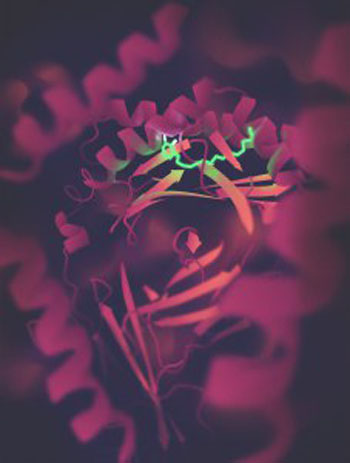CD1a on Langerhans Cells Controls Some Types of Skin Inflammation
By LabMedica International staff writers
Posted on 06 Sep 2016
A team of Australian and American researchers showed that skin inflammation caused by contact with plants such as poison ivy or poison sumac was regulated by the skin cell surface glycoprotein CD1a.Posted on 06 Sep 2016
CD1a (cluster of differentiation 1a) is a lipid-presenting molecule that is abundantly expressed on Langerhans cells. However, the in vivo role of CD1a has remained unclear, principally because CD1a is lacking in mice. To facilitate study of CD1a, investigators at Harvard University (Cambridge, MA, USA) and Monash University (Melbourne, Australia) genetically engineered a line of mice that expressed CD1a and examined the interaction of these animals with the irritant compound urushiol.

Image: An artist\'s depiction of urushiol (in green), the active ingredient in poison ivy, entrapped by CD1a molecule (in pink), which mediates the inflammatory response (Photo courtesy of Monash University).
Urushiol is a mixture of several closely related organic compounds. Each consists of a catechol substituted with an alkyl chain that has 15 or 17 carbon atoms. The alkyl group may be saturated or unsaturated, and the exact composition of the mixture varies, depending on the plant source. The likelihood and severity of allergic reaction to urushiol is dependent on the degree of unsaturation of the alkyl chain. Less than half of the general population experience a reaction with the saturated urushiol alone, but over 90% do so with urushiol that contains at least two degrees of unsaturation (double bonds). Longer side chains tend to produce a stronger reaction. Once absorbed by the skin urushiol is recognized by the immune system's dendritic cells, otherwise called Langerhans cells. These cells then migrate to the lymph nodes, where they present the urushiol to T-lymphocytes and thus recruit them to the skin. Once in the skin, the T-lymphocytes cause irritation through the production of cytokines and cytotoxic damage to the skin.
The investigators found that in the CD1a mouse model, urushiol triggered CD1a-dependent skin inflammation driven by CD4+ helper T-cells that produced the cytokines IL-17 and IL-22 (TH17 cells). Human subjects with poison-ivy dermatitis had a similar cytokine signature following CD1a-mediated recognition of urushiol. Treatment with blocking antibodies to CD1a alleviated skin inflammation.
Among various urushiol components, the investigators identified diunsaturated pentadecylcatechol (C15:2) as the dominant antigen for CD1a-restricted T-cells. Furthermore, they determined the crystal structure of the CD1a-urushiol (C15:2) complex, demonstrating the molecular basis of urushiol interaction with the antigen-binding cleft of CD1a.
"For over 35 years we have known CD1a is abundant in the skin," said contributing author Dr. Jerome Le Nours, a researcher in immunity and infection at Monash University. "Its role in inflammatory skin disorders has been difficult to investigate and until now has been really unclear. Our work, which included imaging the CD1a-urushiol connection, represents clear evidence that CD1a is instrumental in skin-related diseases. We now have a target to further investigate. Our basic discovery may make a big difference in the future treatment and prevention of inflammatory skin diseases."
The study was published in the August 22, 2016, online edition of the journal Nature Immunology.
Related Links:
Harvard University
Monash University













